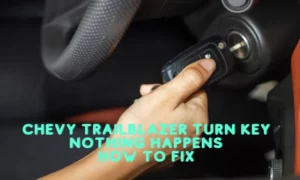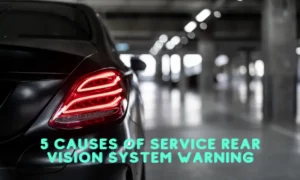Your Chevy Impala’s “Low Oil Pressure Stop Engine” warning indicates a decline in oil pressure. A defective oil pressure sensor often triggers the warning. But it could also be due to a failing oil pump, loose sensor wiring, oil leaks, or a clogged oil filter.
What is a Low Oil Pressure Warning Light?
Every engine needs pressure to ensure that oil circulates through the moving parts. An oil pressure sensor, otherwise known as the sending unit, monitors the oil pressure.
The sensor triggers the “Low Oil Pressure Stop Engine” warning whenever it detects a drop in oil pressure. A chiming sound also accompanies the warning. And depending on what prompted the warning, the “Check Engine Light” may also come on.
Attending to the low-pressure notification immediately after it pops up will go a long way in preventing severe engine damage.
Causes of Low Oil Pressure Warning Light
Several factors could cause a drop in oil pressure. But most times, it is usually due to a failing pressure sensor. Here are the most common reasons your Chevy Impala is beaming the ‘Low Oil Pressure” warning.
Defective oil pressure sensor
The oil pressure sensor monitors the engine’s oil pressure. The sensor triggers a warning whenever the pressure is below the optimal level. This sensor is usually the first component mechanics investigate anytime the low-pressure notification pops up on the driver’s dashboard.
A good sign that something is amiss with the pressure sensor is when you have enough oil in your engine, but the pressure sensor is saying otherwise. Or you get a P0522 or P0523 error code when you scan the ECM.
The sensor’s failure causes inaccurate oil level readings triggering the “Low Oil Pressure” warning. Addressing a defective oil pressure sensor is usually an easy and inexpensive fix.
Failing oil pump
A failing oil pump could also trigger the “Low Oil Pressure” light. And unlike a defective pressure sensor, the damage to the engine from a failing oil pump could turn out catastrophic if the warning is ignored.
The pump circulates the oil throughout the engine for adequate lubrication of the moving components. When the pump fails, the engine won’t get proper lubrication, causing the moving parts to grind against one another.
But, the pressure sensor notifies the driver by activating the “Low Oil Pressure” warning before any engine damage occurs. Hence, anytime the sensor sets off the low-pressure warning, you should stop to investigate what triggered it.
Clogged oil filter
Over time, the oil filter becomes clogged from repeated filtration and needs replacing. This is why every manufacturer has a recommended service interval.
Driving past the recommended oil or filter change interval allows particles to clog up the filter. This reduces oil circulation around the engine, causing a drop in oil pressure. The consequent decline in oil pressure triggers the pressure warning.
Loose sensor wiring
The oil pressure sensor wiring transmits the oil readings to the vehicle ECM. The failure of the sensor wiring would often result in false oil level readings, which prompts a false “Low Oil Pressure” warning.
Oil leaks
A comprised engine block, oil pan, drain plug, valve cover, gaskets, or seals would allow oil to seep out of the engine. The oil leak causes a decline in oil pressure, prompting the sensor to set off the low oil pressure alarm to warn the driver to stop driving.
What Should I Do When the Oil Pressure Warning Comes On
Whenever you notice the “Low Oil Pressure Stop Engine” warning, you should pull off to the side of the road and turn off the engine.
Sometimes, the engine may come back on without the pressure warning after leaving it for some minutes. You shouldn’t drive the car until you’ve investigated what triggered the alarm.
The malfunction may have resulted from a minor sensor failure. But it could also originate from other issues that could possibly cause irreparable engine damage when ignored.
Here’s how to proceed after pulling off the road
- Shut off the engine and pop the hood
- Remove the oil dipstick, wipe it clean and reinsert it before checking the oil level to get the most accurate reading.
- If the oil is at the “full” mark, you are most certainly dealing with a faulty pressure-sending unit. You can further ascertain this by scanning the ECM — a P0522 or P0523 error code is the smoking gun you need
- But if the oil level is on or below the “low” mark, it could be anything from an oil leak to a bad oil pump or clogged filter. Whatever it might be, it requires urgent attention.
Ordering a tow truck after you’ve ascertained what triggered the alarm is the best move. Because the probability of a catastrophic engine failure is too high when driving with a low-pressure warning.
How to Fix Chevy Impala Low Oil Pressure Warning Light
The possible solution may be pretty cheap or cost a fortune, depending on what triggered the warning.
Most time, the low-pressure warning is usually set off by a defective oil pressure sensor. Suppose a faulty sensor sets off your pressure warning. You are lucky because replacing a sensor is relatively inexpensive and straightforward.
However, you may end up with a hefty repair bill if other factors like a defective oil pump, clogged filter, or oil leak triggered the pressure warning.
Final Thoughts
Whenever the “Low Oil Pressure Stop Engine” warning goes off, it means two things. Either the oil pressure sensor is faulty, causing a false pressure reading or the engine oil pressure is, in fact, low.
But oftentimes, a faulty pressure sensor is the culprit. However, you should never take a gamble whenever the warning pops up, as you don’t want your engine components grinding against one another. Park your car and check the oil level.
If your oil dipstick is at or below the “low” point, your oil is running low. But if it is at the “full” mark, you have a faulty oil sensor.







